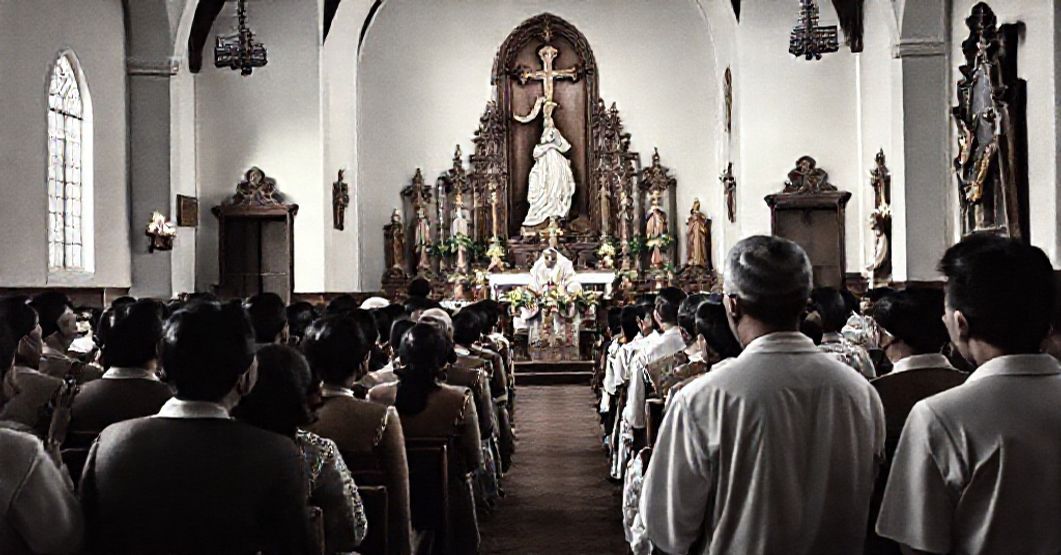Antipopes of the Antichurch



















Timeline of this heretical pontiff
Encyclical Letters
+ 15 posts1959
+ 7 posts1961
+ 4 posts1962
+ 2 posts1963
+ 2 postsApostolic Exhortations
+ 3 postsApostolic Constitutions
+ 93 posts1958
+ 6 posts1959
+ 87 postsMotu Proprio
+ 15 posts1958
+ 1 posts1959
+ 1 posts1962
+ 11 postsApostolic Letters
+ 151 posts1958
+ 4 posts1959
+ 63 posts1960
+ 78 posts1961
+ 1 posts1962
+ 4 posts1963
+ 1 postsSpeeches
+ 99 posts1958
+ 2 posts1959
+ 26 posts1960
+ 29 posts1961
+ 16 posts1962
+ 24 postsMessages
+ 6 posts1959
+ 4 postsHomilies
+ 4 postsLetters
+ 152 posts1958
+ 1 posts1959
+ 48 posts1960
+ 32 posts1961
+ 31 posts1962
+ 30 posts1963
+ 10 postsNot categorized
+ 1 posts1958
+ 1 postsNews feed


Nuntius radiophonicus ad Philippinas (1959.12.06)
This radiophonic message of John XXIII, addressed to the hierarchy and faithful of the Philippine Islands at the close of a “missionary year” in 1959, praises their initiatives, exalts their zeal for propagating Catholic faith, encourages generosity for “sacred expeditions” and missionary works, and concludes with an ostensibly pious blessing invoking Our Lord and the Blessed Virgin of the Rosary. Behind the ornamented phrases of missionary enthusiasm, however, the text already manifests the subtle displacement of the true Catholic mission by a conciliatory, naturalized, and proto-conciliar vision that would soon mature into the conciliar revolution itself.


La Ioannes XXIII radiophonic message (1958.10.29)
On October 29, 1958, shortly after the death of Pius XII, Angelo Roncalli as “John XXIII” delivered from the Sistine Chapel a solemn radio message to the “entire Catholic world.” He presents himself as unexpectedly burdened by the papal office, extends paternal greetings and blessings to the “Sacred College,” bishops, clergy, religious, laity, with particular sympathy for persecuted Catholics, calls civil rulers to peace and disarmament, and appeals to separated Eastern Christians and other non-Catholics to return to unity under the Roman See. The text culminates in a discourse on peace as ordered concord, invoking Augustine and classical authors, and concludes with a Urbi et Orbi-style benediction.


MAGNIFICI EVENTUS (1963.05.11)
LA IOANNES PP. XXIII, the usurper known as John XXIII, addresses the bishops of Slavic nations on the 11th centenary of the arrival of Saints Cyril and Methodius in Great Moravia, praising their missionary work, their attachment to Rome, their use of the Slavic language in liturgy, and proposing them as patrons and models for contemporary efforts toward “unity,” especially in the context of the ongoing Vatican II and aspirations for reconciliation with the Eastern churches. The letter weaves together historical recollection, exhortations to devotion, and an ecumenical program, subtly employing the figures of Cyril and Methodius to legitimize the conciliar revolution and a new vision of “unity” detached from the integral, exclusive claims of the Catholic Church.


Oecumenicum Concilium (1962.04.28)
Ioannes Roncalli, styling himself “John XXIII,” issues an apostolic letter urging the bishops and clergy of the neo-church to promote the Marian month of May and, above all, the recitation of the Rosary “for the happy outcome” of the so‑called Second Vatican Ecumenical Council. He wraps this appeal in sentimental Marian devotion, scriptural allusions to the Ascension and Pentecost, and pious exhortations about grace, holiness, charity, and the “Kingdom of God,” presenting the upcoming council as a “new Pentecost” meant to adapt (“aptabitur”) the Church’s structure to “the conditions of our times.”
Varia
Announcement:
– News feed –implemented
– Antipopes separate web sites with their all documents refutation – in progress
